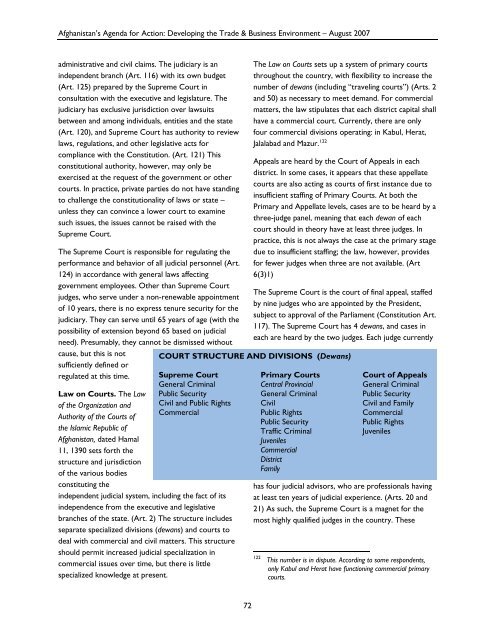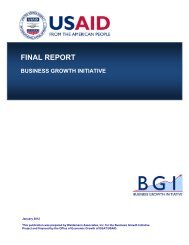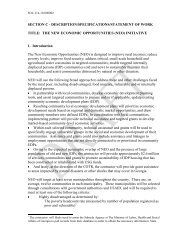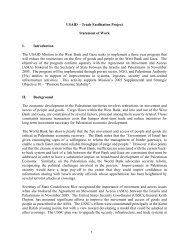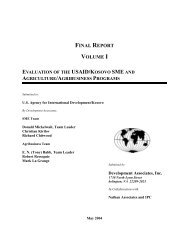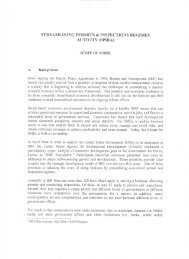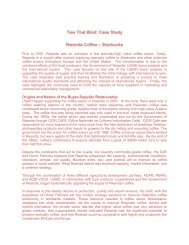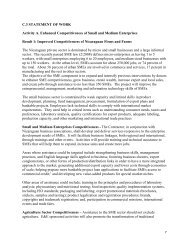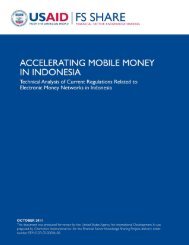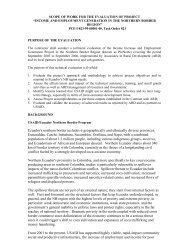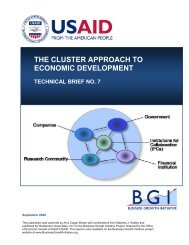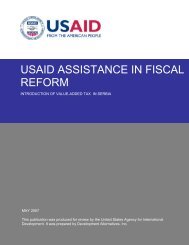Afghanistan’s <strong>Agenda</strong> <strong>for</strong> <strong>Action</strong>: Developing the Trade & Business Environment – August 2007of the developing economy, if applied. There are somegaps, but the basic system of commercial procedure –on paper – will not need substantial amendment <strong>for</strong>some years. Arbitration and mediation have <strong>for</strong>mallybeen introduced through the recent adoption of newlaws, and these should also be adequate <strong>for</strong> this stageof development. To the extent that amendments arecurrently needed, most changes can be accomplishedthrough regulation and internal decree, withoutrecourse to the more difficult process of amending thecodes.The institutional structures are not so robust. Not onlydid government institutions and civil societyorganizations retreat or disintegrate during the waryears, the underlying educational system was badlydamaged as well. As a result, many of those responsible<strong>for</strong> the administration of justice have minimaleducational and practical qualifications to fulfill theirroles. As the schools are re-established, new and betterqualified judges and lawyers will be available, but it willtake time.The demand <strong>for</strong> re<strong>for</strong>m is significant. A reliable,trustworthy court system is one of the principle pillarsof economic growth. Courts underlie the capacity – orincapacity – of banks to make loans at af<strong>for</strong>dable rates,because the costs and risks of en<strong>for</strong>cement are criticalelements in the calculus of lending. Courts alsodetermine a substantial portion of the stability andsafety that investors need to initiate or increaseinvestment. Without reliable “referees” to fairly applythe “rules of the game”, investors stay out of theinvestment game. Court re<strong>for</strong>m must there<strong>for</strong>e be oneof the highest priorities until the system has beenrestored.The current level of instability in the <strong>for</strong>mal systemsuggests that economic actors must primarily rely onin<strong>for</strong>mal and alternative systems of dispute resolution<strong>for</strong> the immediate future. The shura or jirga systems,while imperfect, enjoy popular legitimacy at manylevels, and even hear conflicts between sophisticatedinvestors. Reliance on these structures has risks, butones that can be managed and reduced. Use of <strong>for</strong>malstructures will increase only as users begin to perceivethem as trustworthy, so that there is likely to be anatural evolution toward use of <strong>for</strong>mal courts, if thecourts provide benefits greater than those currentlyprovided by the shuras and jirgas.The in<strong>for</strong>mal system, at heart, is significantly similar to<strong>for</strong>mal mediation and arbitration systems. As such, itprovides a cultural foundation <strong>for</strong> growth in thesealternatives. While not suitable <strong>for</strong> some types ofconflict, the average business conflict can be handledadequately through these approaches. Indeed, shiftingreliance to alternative <strong>for</strong>ms of resolution will helpcreate a better long-term approach to commercialconflicts, in which the courts will more appropriatelyemerge as the last resort, instead of becoming thebacklogged, unproductive first resort that they havebecome in so many transition countries that do nothave effective CDR.Framework LawsSeveral laws define and govern the courts, providingthem with jurisdiction over commercial disputes.Together, they lay out the structure, rules ofprocedure, and competencies of the judicial system.Separate, additional new laws establish a legal basis <strong>for</strong>arbitration and mediation. This analysis focuses onsystemic strengths and weaknesses of the commercialdispute resolution system; other recent work on thecourts provides highly detailed analyses that need notbe repeated here. 121The Afghan ConstitutionThe Constitution of Afghanistan clearly sets <strong>for</strong>th thejudiciary as a unitary system <strong>for</strong> civil, commercial,121Armytage, Livingstone, “Justice in Afghanistan:Rebuilding Judicial Competence after the Generation ofWar.” Draft prepared <strong>for</strong> the Heidelberg Journal ofInternational Law, edited November 26, 2006. U.S.Agency <strong>for</strong> International Development, “Rule ofLaw Project: Field Study of In<strong>for</strong>mal and CustomaryJustice in Afghanistan and Recommendations onImproving Access to Justice and Relations betweenFormal Courts and In<strong>for</strong>mal Bodies.” April 30, 2005.International Crisis Group, “Afghanistan: JudicialRe<strong>for</strong>m and Transitional Justice.” ICG Asia Report No.45, January 28, 2003. Wardak, Ali, “Building a Post-warJustice System in Afghanistan” Kluwer Publishers, Crime,Law and Social change 41:319-341.71
Afghanistan’s <strong>Agenda</strong> <strong>for</strong> <strong>Action</strong>: Developing the Trade & Business Environment – August 2007administrative and civil claims. The judiciary is anindependent branch (Art. 116) with its own budget(Art. 125) prepared by the Supreme Court inconsultation with the executive and legislature. Thejudiciary has exclusive jurisdiction over lawsuitsbetween and among individuals, entities and the state(Art. 120), and Supreme Court has authority to reviewlaws, regulations, and other legislative acts <strong>for</strong>compliance with the Constitution. (Art. 121) Thisconstitutional authority, however, may only beexercised at the request of the government or othercourts. In practice, private parties do not have standingto challenge the constitutionality of laws or state –unless they can convince a lower court to examinesuch issues, the issues cannot be raised with theSupreme Court.The Supreme Court is responsible <strong>for</strong> regulating theper<strong>for</strong>mance and behavior of all judicial personnel (Art.124) in accordance with general laws affectinggovernment employees. Other than Supreme Courtjudges, who serve under a non-renewable appointmentof 10 years, there is no express tenure security <strong>for</strong> thejudiciary. They can serve until 65 years of age (with thepossibility of extension beyond 65 based on judicialneed). Presumably, they cannot be dismissed withoutcause, but this is notsufficiently defined orregulated at this time.Law on Courts. The Lawof the Organization andAuthority of the Courts ofthe Islamic Republic ofAfghanistan, dated Hamal11, 1390 sets <strong>for</strong>th thestructure and jurisdictionof the various bodiesconstituting theindependent judicial system, including the fact of itsindependence from the executive and legislativebranches of the state. (Art. 2) The structure includesseparate specialized divisions (dewans) and courts todeal with commercial and civil matters. This structureshould permit increased judicial specialization incommercial issues over time, but there is littlespecialized knowledge at present.The Law on Courts sets up a system of primary courtsthroughout the country, with flexibility to increase thenumber of dewans (including “traveling courts”) (Arts. 2and 50) as necessary to meet demand. For commercialmatters, the law stipulates that each district capital shallhave a commercial court. Currently, there are onlyfour commercial divisions operating: in Kabul, Herat,Jalalabad and Mazur. 122Appeals are heard by the Court of Appeals in eachdistrict. In some cases, it appears that these appellatecourts are also acting as courts of first instance due toinsufficient staffing of Primary Courts. At both thePrimary and Appellate levels, cases are to be heard by athree-judge panel, meaning that each dewan of eachcourt should in theory have at least three judges. Inpractice, this is not always the case at the primary stagedue to insufficient staffing; the law, however, provides<strong>for</strong> fewer judges when three are not available. (Art6(3)1)The Supreme Court is the court of final appeal, staffedby nine judges who are appointed by the President,subject to approval of the Parliament (Constitution Art.117). The Supreme Court has 4 dewans, and cases ineach are heard by the two judges. Each judge currentlyCOURT STRUCTURE AND DIVISIONS (Dewans)Supreme Court Primary Courts Court of AppealsGeneral Criminal Central Provincial General CriminalPublic Security General Criminal Public SecurityCivil and Public Rights Civil Civil and FamilyCommercial Public Rights CommercialPublic SecurityTraffic CriminalJuvenilesCommercialDistrictFamilyPublic RightsJuvenileshas four judicial advisors, who are professionals havingat least ten years of judicial experience. (Arts. 20 and21) As such, the Supreme Court is a magnet <strong>for</strong> themost highly qualified judges in the country. These122This number is in dispute. According to some respondents,only Kabul and Herat have functioning commercial primarycourts.72


